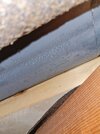Hi, I'm hoping somebody knows an easy fix for this.
Our house has a small two-storey extension at the front so there are now two adjoining sloped roof sections on the house (see pic).
All is fine but there's one problem. The two roof sections have plastic (not lead) roof valleys/channels adjoining them, running rainwater down into gutter. While perfectly watertight, the plastic roof valley material is thin enough to allow large amounts of dripping condensation to form on the underside. (Grey plastic shown on pic taken inside loft). I notice a few places where 2 layers of the plastic 'overlap' and in those places the condensation is absent - because the double thickness provides insulation.
I'm fairly sure the loft ventilation is OK, ensured no ceiling holes allowing hot air in, and it's nice and cold (and reassuringly drafty) up there. But still a few degrees warmer than the outside world, no matter what I do, especially when freezing when rainwater cools down that plastic surface on the outer side. And no amount of ventilation seems to stop the condensation forming under it. Not surprising when you consider it's an exposed, thin 3mm layer of plastic between loft and outside world, nothing covering it up or insulating it.
The moisture drips down the inner slope of the channel and contacts wooden beams along the way, which bothers me as the wood soaks it up. I also suspect some of the condensation is dripping down into the wall cavity (on right hand side of pic), slowly soaking the cavity insulation over time.
Just to emphasise: This isn't rainwater getting in. It's condensation forming on the inside. I think I need to 'warm up' the underside of the plastic to protect it against condensation.
I've tried taping over the underside of roof channel with some heavy duty aluminium foil tape, but that hasn't really helped. I'm next going to try some of that foil bubble-wrap stuff, to insulate the valley in same way you might insulate a pipe.
Anyone got any ideas or faced this same issue before? Thanks
Our house has a small two-storey extension at the front so there are now two adjoining sloped roof sections on the house (see pic).
All is fine but there's one problem. The two roof sections have plastic (not lead) roof valleys/channels adjoining them, running rainwater down into gutter. While perfectly watertight, the plastic roof valley material is thin enough to allow large amounts of dripping condensation to form on the underside. (Grey plastic shown on pic taken inside loft). I notice a few places where 2 layers of the plastic 'overlap' and in those places the condensation is absent - because the double thickness provides insulation.
I'm fairly sure the loft ventilation is OK, ensured no ceiling holes allowing hot air in, and it's nice and cold (and reassuringly drafty) up there. But still a few degrees warmer than the outside world, no matter what I do, especially when freezing when rainwater cools down that plastic surface on the outer side. And no amount of ventilation seems to stop the condensation forming under it. Not surprising when you consider it's an exposed, thin 3mm layer of plastic between loft and outside world, nothing covering it up or insulating it.
The moisture drips down the inner slope of the channel and contacts wooden beams along the way, which bothers me as the wood soaks it up. I also suspect some of the condensation is dripping down into the wall cavity (on right hand side of pic), slowly soaking the cavity insulation over time.
Just to emphasise: This isn't rainwater getting in. It's condensation forming on the inside. I think I need to 'warm up' the underside of the plastic to protect it against condensation.
I've tried taping over the underside of roof channel with some heavy duty aluminium foil tape, but that hasn't really helped. I'm next going to try some of that foil bubble-wrap stuff, to insulate the valley in same way you might insulate a pipe.
Anyone got any ideas or faced this same issue before? Thanks



